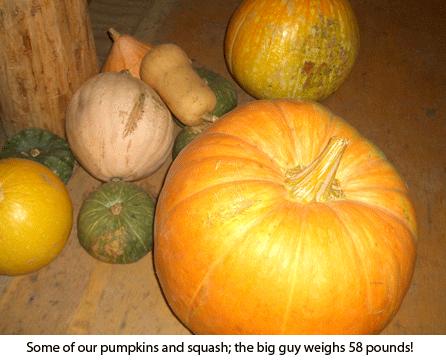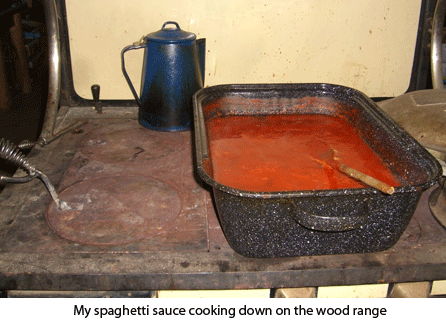As we had some really cold weather move in, we had picked all our pumpkins and squash and held them in the unheated porch. When it got too cold we had to move them into our entryway. Surprisingly, we had great pumpkins this year. This one weighs 58 pounds! Now that’s a lot of pies. The next smallest one weighs 24 pounds, so we’re really happy, considering they were direct seeded into the garden and pretty late, too.

I’m still processing tomatoes. Whew! I’m down to three five-gallon buckets now. Tonight I have another batch of spaghetti sauce on the stove, cooking down. I couldn’t do it in the oven as I picked up more whole pork loins at the store for $1.39 a pound and have the oven full of them, roasting. I’ll be canning the spaghetti sauce AND pork loin tomorrow, as well as straining more tomatoes for even more sauce. Mmmm I think I’ll make barbecue sauce out of the next batch. Sounds good, doesn’t it?

Readers’ Questions:
Transplanting apple trees
I hope you and your family are feeling better! How is your mom?
We planted several of our apple trees in the wrong spot last spring. Can they be transplanted now or should we wait until early spring before the tree breaks dormancy?
Your canning book is great. I tried several recipes in there and they are tasty! I had bountiful tomatoes this year and appreciated all of your recipes.
Cindy Hills
Wild Rose, Wisconsin
Mom is doing much better, but she is very weak and has to go to a rehab facility for physical building up before she can come back home. It was a tough go at 93.
I would wait until spring, while the trees are still dormant, to transplant them. If you do it now, it’d be more stress on them, I think.
I’m glad you liked the recipes in the new book. It always makes me happy to share the ones I like. — Jackie
Pumpkin butter
I bought your new book (I have your others too) and it is great! Thank you. I am new to canning and thought pumpkin butter sounded good. Can I make pumpkin butter and if so, how?
Carole-Anne Hopkins
Riverton, Wyoming
Like pureed pumpkin and squash, it is not recommended that you can pumpkin butter. You CAN make it and store it in the fridge, however. All you do is puree cooked pumpkin, add cinnamon, cloves, and allspice to your puree, then very slowly cook it down, stirring to prevent scorching. You can add sugar or honey to sweeten it, if you wish. When it is thick, put it in a jar and store it in the fridge. It’ll be good for quite a few weeks. Enjoy! — Jackie
Planting potatoes
I am very impressed with your potato harvest this year. It doesn’t matter what we try, we haven’t been able to grow potatoes. We have planted in the ground, the old fashioned way. We have tried planting in tires for several years and this year, for the very first time, we actually got a bucket full. But in reality, I barely harvested double the amount in pounds than I planted. What is your method? I really want to grow potatoes next year.
Julie Meares
Neosho Rapids, Kansas
Potatoes are a cool weather lover, but don’t like extended periods of cold weather. We plant about two weeks before the last spring frosts are due, in well worked up soil. Watch the manure and heavy fertilized ground; it causes scabby potatoes and sometimes lumpy, bumpy ones. I plant either whole or cut potatoes with at least three eyes that have sturdy, short sprouts. The sprouts/eyes are planted on the topside. I go down the row with my hoe, digging depressions about four inches deep, about a foot apart, with the rows about three feet apart to allow for hilling later. Then I go back and set the seed potatoes in the holes and cover them up with loose soil. If they begin to emerge from the soil and the nights are frosty, I toss a little more dirt over them so they don’t get frost-burned.
I keep my potato rows watered but not soggy. Too much water and they’ll rot in the ground; not enough and they will grow slowly. As the plants get taller, about eight inches, I go down the rows with a hoe, dragging dirt from the center of the row to nearly cover each plant. This is “hilling” and it makes more potatoes from each plant than if you just left it alone. I hill twice then let the plants grow. Be sure to water frequently during dry weather, especially when the plants start to bloom. That’s when they are beginning to set new potatoes. Keep them watered regularly as potatoes have a high water content and need it.
To harvest, wait till the vines brown and die back, then dig before freezing weather.
I hope this helps you grow great potatoes next year. You can get a start this fall by tilling in leaves, straw or other non-manure based organic material. It’ll help improve your soil, yet prevent scab in your taters. — Jackie
Squash cross pollinating
We (granddaughter and I) planted the Hopi Pale Gray squash seeds you sent, in a “Three Sisters” garden, so she could learn about how the Indians did it (she’s almost five). I had some real heirloom red corn, and some Lazy Housewife beans, and the squash. She was real excited about it, and can still explain the process, and boy did it grow! Everything came on real nice, even with the cold weather. But some of the squash came out twice as big as it should have, and it ranged from pale to pinkish orange. The rest looks to be the right size and color. My question — will the seed from this planting still be good, or is there a risk of cross-pollination here, even though I had no other squash or pumpkins planted?
Howard Tuckey
Lisle, New York
Oops! Your squash had a “skunk in the woodpile.” My mistake, too. Last year, I planted Amish pie pumpkin in my garden, thinking it was a C. pepo. Well this year my friend brought it to my attention that it was really a C. maxima, which is what Hopi Pale Grey squash is. So your squash seed was inadvertently a cross. But you can save the seed from the traditional looking squash and breed it back to purebred Hopi in a couple of generations. Sorry about that. (But some “surprises” like this are actually kind of fun. Native Americans seldom had “pure” crops, only ones that they grew year after year.) — Jackie
Pie pumpkins
I have two questions. First off, is there a difference between pie pumpkins and the pumpkins they sell for Halloween carving?
Also I have two year and a half old hens. I recently received seven 5-week old pullets but every time I try to put them together one of the hens goes after the pullets and tries to kill them. how do I bring them together?
Rich Smith
Irwin, Pennsylvania
“Pie” pumpkins are sometimes thicker meated and somewhat sweeter than “plain old” pumpkins, but I’ve made tons and tons of pies from “plain old” pumpkins! And I can’t tell any difference in the end product.
Wait until your pullets are older and more “chicken” sized. Then try putting your outlaw hen in with the pullets instead of the other way around. In their territory, she may be less aggressive. And, if they’re bigger, that may also help stop her nasty behavior. — Jackie
Parboiling rice for storage
I would like to know how to parboil brown rice for long term storage. I am going to teach a disaster preparedness class and thought this would be a great to do instead of spending the extra money for the minute rice. This class is for lower income clients of my churches food pantry I’m trying to figure out how to make it so that we don’t have to waste a lot of fuel. We are in Earthquake country California.
Odessa Ketelsen
Capitola, California
The trouble is that once you parboil rice, you shorten its storage life. When fuel is a serious concern, or the lack of it, I’d suggest using white rice, which cooks much quicker and requires less fuel to do it. Plain white rice may not be as nutritious as brown rice, but in a disaster, ease of cooking becomes a huge concern, as you said. To make up for the lack of nutrients in the white rice, add bullion, dehydrated vegetables, and meat. Not only do you have a quick meal, but one that is nutritious, as well. Good luck with your class. It’s such a good idea! — Jackie
Keeping voles away from the garden
We planted sweet potatoes this year and had a great turnout, BUT, the voles enjoyed them before we did and more than 1/2 of them were eaten on. What can we do to keep them away from the garden short of using the little buggers for target practice?
Bea Ward
St. Paris, Ohio
Voles can be a real problem sometimes. To help keep them away from your garden, try to establish a clear area of some width all around your garden. In this, keep the soil tilled or mowed quite short. Voles fear natural predators and love long grass and weeds to hide in. They do not feel safe when traveling across open ground; i.e. they may choose not to invade your garden. Also having a good outside cat does much to do away with voles. Our old cat, Monty, is an indoor cat, but spends quite a bit of time outside. Hunting is his hobby and he’s quite good at it, even though he’s 17 years old. We have no voles in sight. And after having voles girdle 23 of my young apple trees back on the farm, I really, really don’t like them!
I’m glad you got a good yield on your sweet potatoes. At least the voles left you half of them! — Jackie
Rusty canning lids
I have a question regarding rusty canning lids. My wife says the Ball canning book says to not use them. I say they can be glass beaded and wiped down with vegetable oil to inhibit new rust and will be fine. What is your expert opinion. By the way, we also care for my elderly mother and sympathize with your trials. Keep up the good work and God Bless you for it.
Michael Fink
Cougar, Washington
I’d say that it depends on how rusty your lids are. If there’s just a bit of surface rust and the lids are not roughened or pitted, I, personally, would have no problem using them. But if they have serious rust, I would toss them and get new ones as they won’t last on your jars of food as long as you may need them to. — Jackie


